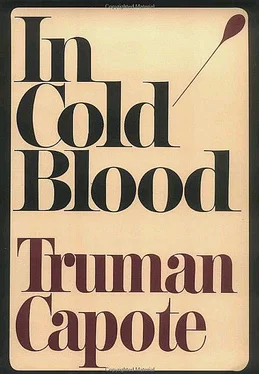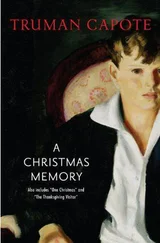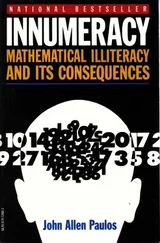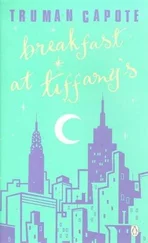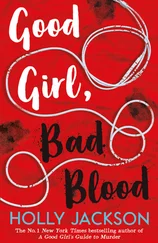Toward the end, a total of eighteen men were assigned to the case full time, among them three of the K.B.I.’s ablest investigators—Special Agents Harold Nye, Roy Church, and Clarence Duntz. With the arrival in Garden City of this trio, Dewey was satisfied that “a strong team” had been assembled. “Somebody better watch out,” he said.
The sheriff’s office is on the third floor of the Finney County courthouse, an ordinary stone-and-cement building standing in the center of an otherwise attractive tree-filled square. Nowadays, Garden City, which was once a rather raucous frontier town, is quite subdued. On the whole, the sheriff doesn’t do much business, and his office, three sparsely furnished rooms, is ordinarily a quiet place popular with courthouse idlers; Mrs. Edna Richardton, his hospitable secretary, usually has a pot of coffee going and plenty of time to “chew the fat.” Or did, until, as she complained, Clutter thing came along,” bringing with it “all these out-of-towners, all this newspaper fuss.” The case, then commending headlines as far east as Chicago, as far west as Denver, had indeed lured to Garden City a considerable press corps.
On Monday, at midday, Dewey held a press conference in the sheriff’s office. “I’ll talk facts but not theories,” he informed the assembled journalists. “Now, the big fact here, the thing to remember, is we’re not dealing with one murder but four. And we’ don’t know which of the four was the main target. The primary victim. It could have been Nancy or Kenyon, or either of their parents. Some people say, Well, it must have been Mr. Clutter. Because his throat was cut; he was the most abused. But that’s theory, not fact. It would help if we knew in what order the family died, but the coroner can’t tell us that; he only knows the murders happened sometime between eleven p.m. Saturday and two a.m. Sunday.” Then, responding to questions, he said no, neither of the women had been “sexually molested,” and no, as far as was presently known, nothing had been stolen from the house, and yes, he did think it a “queer coincidence” that Mr. Clutter should have taken out a forty-thousand-dollar life-insurance policy, with double indemnity, within eight hours of his death. However, Dewey was “pretty darn sure” that no connection existed between this purchase and the crime; how could there be one, when the only persons who benefited financially were Mr. Clutter’s two surviving children, the elder daughters, Mrs. Donald Jarchow and Miss Beverly Clutter? And yes, he told the reporters, he did have an opinion on whether the murders were the work of one man or two, but he preferred not to disclose it.
Actually, at this time, on this subject, Dewey was undecided. He still entertained a pair of opinions—or, to use his word, “concepts”—and, in reconstructing the crime, had developed both a “single-killer concept” and a “double-killer concept.” In the former, the murderer was thought to be a friend of the family, or, at any rate, a man with more than casual knowledge of the house and its inhabitants—someone who knew that the doors were seldom locked, that Mr. Clutter slept alone in the master bedroom on the ground floor, that Mrs. Clutter and the children occupied separate bedrooms on the second floor. This person, so Dewey imagined, approached the house on foot, probably around midnight. The windows were dark, the Clutters asleep, and as for Teddy, the farm’s watchdog—well, Teddy was famously gun-shy. He would have cringed at the sight of the intruder’s weapon, whimpered, and crept away. On entering the house, the killer first disposed of the telephone installations—one in Mr. Clutter’s office, the other in the kitchen—and then, after cutting the wires, he went to Mr. Clutter’s bedroom and awakened him. Mr. Clutter, at the mercy of the gun-bearing visitor, was forced to obey instructions—forced to accompany him to the second floor, where they aroused the rest of the family. Then, with cord and adhesive tape supplied by the killer, Mr. Clutter bound and gagged his wife, bound his daughter (who, inexplicably, had not been gagged), and roped them to their beds. Next, father and son were escorted to the basement, and there Mr. Clutter was made to tape Kenyon and tie him to the playroom couch. Then Mr. Clutter was taken into the furnace room, hit on the head, gagged, and trussed. Now free to do as he pleased, the murderer killed them one by one, each time carefully collecting the discharged shell. When he had finished, he turned out all the lights and left.
It might have happened that way; if was just possible. But Dewey had doubts: “If Herb had thought his family was in danger, mortal danger, he would have fought like a tiger. And Herb was no ninny—a strong guy in top condition. Kenyon too—big as his dad, bigger, a big-shouldered boy. It’s hard to see how one man, armed or not, could have handled the two of them.” More over, there was reason to suppose that all four had been bound by the same person: in all four instances the same type of knot, a half hitch, was used.
Dewey—and the majority of his colleagues, as well—favored the second hypothesis, which in many essentials followed the first, the important difference being that the killer was not alone but had an accomplice, who helped subdue the family, tape, and tie them. Still, as a theory, this, too, had its faults. Dewey, for example, found it difficult to understand “how two individuals could reach the same degree of rage, the kind of psychopathic rage it took to commit such a crime.” He went on to explain: “Assuming murderer was someone known to the family, a member of this community; assuming that he was an ordinary man, ordinary except that he had a quirk, an insane grudge against the Clutters, or of the Clutters—where did he find a partner, someone crazy enough to help him? It doesn’t add up. It doesn’t make sense. But then, come right down to it, nothing does.”
After the news conference, Dewey retired to his office, a room the sheriff had temporarily lent him. It contained a desk and straight chairs. The desk was littered with what Dewey would some day constitute courtroom exhibits: the adhesive tape and the yards of cord removed from the victims and sealed in plastic sacks (as clues, neither item seemed very promising, for both were common-brand products, obtainable here in the United States), and photographs taken at the scene of the crime by a police photographer—twenty blown-up glossy-print pictures of Mr. Clutter’s shattered skull, his son’s demolished face, Nancy’s bound hands, her mother’s death-dulled, staring eyes, and so on. In days to come, Dewey was to spend hours examining these photographs, hoping that he might suddenly see something,” that a meaningful detail would declare itself. “Like those puzzles. The ones that ask, ‘How many animals can you find in this picture?’ In a way, that’s what I’m trying to do. Find the hidden animals. I feel they must be there—if only I could see them. “ As a matter of fact, one of the photographs, a close-up of Mr. Clutter and the mattress box upon which he lay, already provided a valuable surprise: footprints, the dusty trackings of shoes with diamond-patterned soles. The prints, not noticeable to the naked eye, registered on film; indeed, the delineating glare of a flashbulb had revealed their presence with superb exactness. These prints, together with another footmark found on the same cardboard cover—the bold and bloody impression of a Cat’s Paw half sole—were the only “serious clues” the investigators could claim. Not that they were claiming them; Dewey and his team had decided to keep secret the existence of this evidence. Among the other articles on Dewey’s desk was Nancy Clutter’s diary. He had glanced through it, no more than that, and now he settled down to an earnest reading of the day-by-day entries, which began on her thirteenth birthday and ended some two months short of her seventeenth; the unsensational confidings of an intelligent child who adored animals, who liked to read, cook, sew, dance, ride horseback—a popular, pretty, virginal girl who thought it “fun to flirt” but was nevertheless “only really and truly in love with Bobby.” Dewey read the final entry first. It consisted of three lines written an hour or two before she died: “Jolene K. came over and I showed her how to make a cherry pie. Practiced with Roxie. Bobby here and we watched TV. Left at eleven.”
Читать дальше
